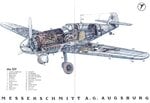Let's say that Willy has a lightbulb moment before 1935, comes out with a 2-seat aircraft consisted mainly of parts of early Bf 109, with ~900 L of fuel, and wins the RLM contract that Bf 110 historically won. Basically, a 'pre-Bf-109Z'. Aircraft is size of Whirlwind. Development goes on in subsequent years, there is no Me 210 as we know and don't like.
What kind of performance we can expect, both as-is and with DB engines installed, armament set-up, numbers produced vs. Bf 110 and Me 210, possible impact on air war and development in other countries?
What kind of performance we can expect, both as-is and with DB engines installed, armament set-up, numbers produced vs. Bf 110 and Me 210, possible impact on air war and development in other countries?

